
 |
Tea Clipper |
 |
| from TeaAntiques.com | ||
| Edition Fifteen |
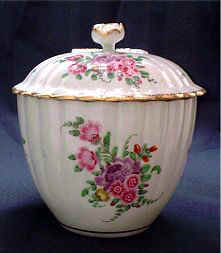 My Tea Featured Antique is a charming Worcester Sugar Box and Cover with straight
fluted sides and Flower lid finial, c1770.
My Tea Featured Antique is a charming Worcester Sugar Box and Cover with straight
fluted sides and Flower lid finial, c1770.
This item beautifully reflects the elegance of the period of the Eighteenth Century England, as reviewed below in the article on the Late Georgian period at the Geffrye Museum, London.
More details of this item can be found by visiting the Porcelain section of my web site at www.TeaAntiques.com
Now that Christmas has past, the mayhem of the January sales is upon us! For those fortunate enough to be in London for the sales, I strongly recommend that you take a break and give yourself some peace by visiting the Geffrye museum, Kingsland Road, London. I have previously reviewed this museum in Editions 5 and 7 of Tea Clipper, when I reviewed the Regency and Victorian periods respectively. In this edition I return to look at my favourite period - 'Late Georgian' 1770-1800 - as portrayed by the museum.
To think of the last quarter of the eighteenth century, the styles and strong influences of Robert Adam come to mind, a masterly architect of neo-classical designs. This was then a brand new style in England, introduced around 1760. With inspiration taken from tours of Italy, interiors of English houses became light and delicate, decorated with patterns derived from classical art. These designs produced motifs such as garlands of foliage, architectural urns, scrolls and arabesques. Motifs that are still used and remain popular in architecture today.
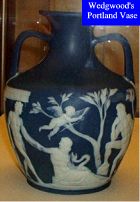 In
the mid to late eighteenth century, these neo-classical designs were taken up by
other designers and cabinet makers such as Thomas Chippendale, George Hepplewhite
and Thomas Sheraton. Not only cabinet makers follow the fashion, so did potters
and silversmiths - Josiah Wedgwood introduced the classical 'jasper wares'. The
most popular being the blue jasper ware with the applied white reliefs of classical
figures and motifs - none more famous than his "Portland Vase". This was
a replica made c1789 of the famous Roman glass Portland Vase from early 1st century
BC. Both the original and Wedgwood's "copy" are now housed in the British
Museum in London.
In
the mid to late eighteenth century, these neo-classical designs were taken up by
other designers and cabinet makers such as Thomas Chippendale, George Hepplewhite
and Thomas Sheraton. Not only cabinet makers follow the fashion, so did potters
and silversmiths - Josiah Wedgwood introduced the classical 'jasper wares'. The
most popular being the blue jasper ware with the applied white reliefs of classical
figures and motifs - none more famous than his "Portland Vase". This was
a replica made c1789 of the famous Roman glass Portland Vase from early 1st century
BC. Both the original and Wedgwood's "copy" are now housed in the British
Museum in London.
In this period of English history there was a vast increase in trade and industry resulting in a wider range of affordable upholstery, fabrics, wall papers, carpets, furniture and ornaments. There was new wealth and the creation of the 'middle classes' of traders, merchants, bankers etc, all eager to express their wealth and social standing.
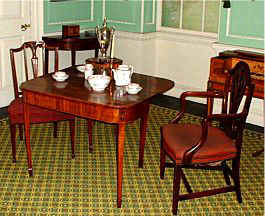 The
late Georgian setting in the Geffrye museum, shows how the taste for the simplicity,
symmetry and elegance of neo-classical design was adopted not only by the aristocracy,
but by the expanding middle classes. This particular room shows a middle class drawing
room of a London house. This room would have been used for quite formal entertaining;
such as afternoon tea parties for the ladies and maybe for musical recitals
or card playing in the evening. Such events were then expected of 'society', which
was very important for proclaiming your social standing. Georgian houses were
designed to provide entrance halls and reception rooms that would impress guests
and proclaim your wealthy position.
The
late Georgian setting in the Geffrye museum, shows how the taste for the simplicity,
symmetry and elegance of neo-classical design was adopted not only by the aristocracy,
but by the expanding middle classes. This particular room shows a middle class drawing
room of a London house. This room would have been used for quite formal entertaining;
such as afternoon tea parties for the ladies and maybe for musical recitals
or card playing in the evening. Such events were then expected of 'society', which
was very important for proclaiming your social standing. Georgian houses were
designed to provide entrance halls and reception rooms that would impress guests
and proclaim your wealthy position.
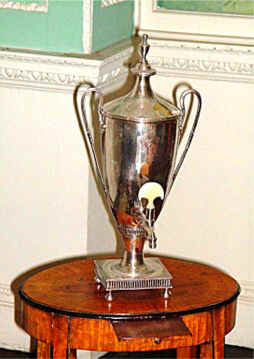
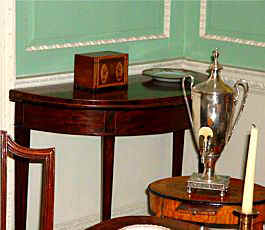 Classical
references can be seen in many of the items on display, such as the silver plated
tea urn, c1790, used to provide hot water at the tea table.
Classical
references can be seen in many of the items on display, such as the silver plated
tea urn, c1790, used to provide hot water at the tea table.
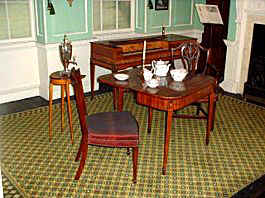 Items
of furniture in this room includes a folding mahogany tea table, c1785, which is
embellished with box wood stringing and marquetry inlays. Such a table could double
for use as a card table and when not required, would be folded away and placed against
the wall.
Items
of furniture in this room includes a folding mahogany tea table, c1785, which is
embellished with box wood stringing and marquetry inlays. Such a table could double
for use as a card table and when not required, would be folded away and placed against
the wall.
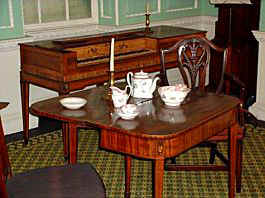 For
musical entertainment, there is a square piano which was made by Christopher Garner
in London, c1785. The case of the piano is in mahogany and satinwood, with box wood
and ebony stringing. Such an instrument would be played by members of the household
and provide much entertainment for the family and guests.
For
musical entertainment, there is a square piano which was made by Christopher Garner
in London, c1785. The case of the piano is in mahogany and satinwood, with box wood
and ebony stringing. Such an instrument would be played by members of the household
and provide much entertainment for the family and guests.
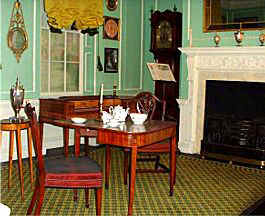 The
shield backed arm chair, so beautifully light and delicate in its design, is in
the style of George Hepplewhite and dates from around 1785.
The
shield backed arm chair, so beautifully light and delicate in its design, is in
the style of George Hepplewhite and dates from around 1785.
The silver plated tea urn sits very elegantly on an urn stand, veneered in exquisite satin wood on a pine carcase c1795. There is some ebony stringing to give it that extra lift to its appearance.
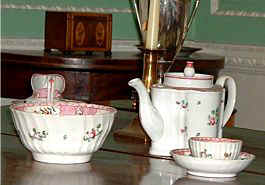 For
the lover of tea wares, there is part of a beautiful New Hall tea service c1800.
The teapot is in the 'silver shape', so called as it was following the fashionable
shaped silver design of the period, with shaped vertical sides (see below for a
further discussion on this). Porcelain styles copied those of the silver styles
and shapes, usually lagging by a period of ten to twenty years. The pieces to this
set including the tea bowls and saucers are decorated with lovely neo-classical
flowers in coloured enamels. A tea caddy is also on display, made from satin wood
and having box wood inlay, it stands on ebony feet and was made c1790.
For
the lover of tea wares, there is part of a beautiful New Hall tea service c1800.
The teapot is in the 'silver shape', so called as it was following the fashionable
shaped silver design of the period, with shaped vertical sides (see below for a
further discussion on this). Porcelain styles copied those of the silver styles
and shapes, usually lagging by a period of ten to twenty years. The pieces to this
set including the tea bowls and saucers are decorated with lovely neo-classical
flowers in coloured enamels. A tea caddy is also on display, made from satin wood
and having box wood inlay, it stands on ebony feet and was made c1790.
This certainly is a most beautiful little room, most delicately furnished and quite epitomises the elegance of this period in English Georgian history.
Remember that there is a good tea room within the museum, should you wish to partake of tea and refreshments, (as reviewed previously in Edition 5 of Tea Clipper).
For opening details and directions please see the March 2001 issue of Tea Clipper, or visit the museums web site: www.geffrye-museum.org.uk
Did you know that George III from an early age, was obsessed with not becoming obese like his fat uncles? He was determined not to follow in their foot steps and so between breakfast and evening dinner, he ate only a slice of bread and butter accompanied by black tea. He was successful in maintaining his figure well into middle age. Maybe after the excesses of Christmas this is a wise diet to adopt today?
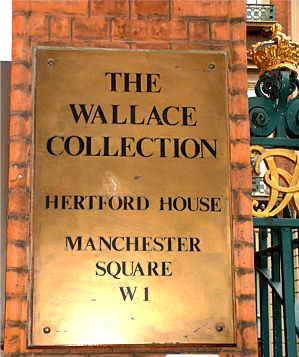
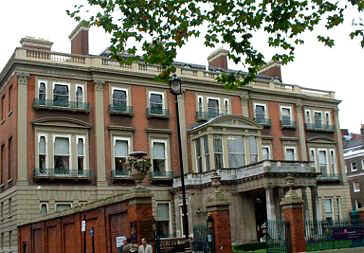 If
you are in London for the sales, then there is a retreat which is full of treasures
to behold and an idyllic place to which you can escape for a wonderful afternoon
tea. I am referring to The Wallace Collection, housed in Hertford House, just a
few minutes walk from the main shopping area of Oxford Street, in Manchester Square,
London, W1U 3BN. The Wallace Collection is one of the grandest collections of arts
and treasures assembled by one family. The treasures include the very finest of
eighteenth century French furniture, clocks, paintings, porcelain, bronzes and silver.
In particular for the lover of tea related antiques, there are many examples of
the most elaborate Sevré tea wares with sumptuous blue, turquoise and green grounds.
If
you are in London for the sales, then there is a retreat which is full of treasures
to behold and an idyllic place to which you can escape for a wonderful afternoon
tea. I am referring to The Wallace Collection, housed in Hertford House, just a
few minutes walk from the main shopping area of Oxford Street, in Manchester Square,
London, W1U 3BN. The Wallace Collection is one of the grandest collections of arts
and treasures assembled by one family. The treasures include the very finest of
eighteenth century French furniture, clocks, paintings, porcelain, bronzes and silver.
In particular for the lover of tea related antiques, there are many examples of
the most elaborate Sevré tea wares with sumptuous blue, turquoise and green grounds.
There is free admission to the museums collection, housed in a very handsome large detached house on the far side of the Square. To make this more exciting to visit, located in a glass covered central court there is an excellent and friendly Café called 'Café Bagatelle'.
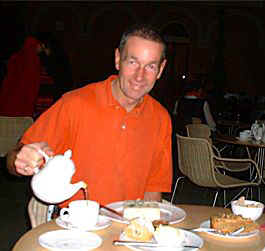
I had the pleasure of taking afternoon tea there recently as part of a visit to the Wallace Collection. I must say I found it a complete treat. They offer lunches as well as various savouries and cakes for afternoon tea. I thought I would try their full afternoon tea and I was not to be disappointed.
I was served with a selection of white and brown finger sandwiches, including
smoked salmon, a pleasant fruit scone with a small pot of jam and some of the best
and smoothest thick clotted cream
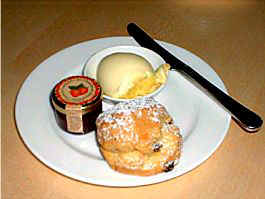 I
have tasted! Also as part of the tea there was a choice of cake, I went for Coffee
and Walnut which was very moist and rounded the tea off beautifully. It made a very
relaxing break from the crush of Oxford Street shopping and fully intend to return
to this Café often when in London.
I
have tasted! Also as part of the tea there was a choice of cake, I went for Coffee
and Walnut which was very moist and rounded the tea off beautifully. It made a very
relaxing break from the crush of Oxford Street shopping and fully intend to return
to this Café often when in London.
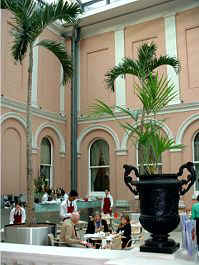 If
you wish to visit the Wallace Collection and the Café Bagatelle the details are:
If
you wish to visit the Wallace Collection and the Café Bagatelle the details are:
The Wallace Collection,
Hertford House,
Manchester Square,
London,
W1U 3BN
Tel: 020 7563 9500
web site: www.wallace-collection.org.uk
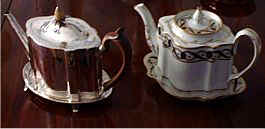 Porcelain
teapot styles generally copied the shapes of silver teapots, maybe lagging in design
by about ten years. The picture shows an example of two such silver shaped teapots.
Porcelain
teapot styles generally copied the shapes of silver teapots, maybe lagging in design
by about ten years. The picture shows an example of two such silver shaped teapots.
The silver bright cut teapot, with its vertical and shaped sides, slightly domed lid capped with an ivory pineapple finial, was made by George Burrows in London in 1789.
As can be seen, the porcelain teapot bears the same basic shape as that of the silver teapot, also having shaped vertical sides and a lid finial shaped rather like a pineapple too. This elegant porcelain teapot, complete with its shaped stand was manufactured at the New Hall factory c17985-1805.
To review past newsletters, just follow this link:
Past newsletters.
To subscribe to this free newsletter -
Click here